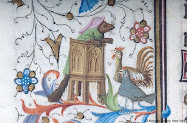One aspect of medieval history that I find fascinating is the use of structures of marginalisation and ‘otherness’ – both figurative and literal – to define and defend hierarchies of power in society. I recently completed a research project exploring how the masculine power elites of medieval European societies implicitly controlled all women – keeping them in their ‘proper’ subordinate place in society – by explicitly controlling and regulating the sexuality of those termed 'common women' (sex workers, in modern parlance – although not all were exchanging sex for money). This was usually achieved through municipal regulation of sex work, by formally or informally restricting women’s use of public space, and through religious discourses that defined all women as either virgins/wives/mothers (belonging to one man) or whores (‘common’ to all men). In some places, this binary was explicitly enforced; a 15th century customary that regulated the stews of Southwark stated no pregnant women was allowed to work in the brothels and no ‘common women’ could take a particular lover.
Well, plus ça change and all that. I am being powerfully reminded of those discourses by recent media coverage of self-appointed 'community leaders' trying to prevent street-based sex workers from operating (legally, under New Zealand’s Prostitution Reform Act 2003) in their area. Their campaign includes tracking down clients through their car registrations and sending them letters warning them of the ‘dangers’ of commercial sex. These vigilantes also intend to send letters to clients’ homes so their ‘wives and families know what they’re up to’.
There is so much wrong with this, I don’t know where to start. Probably with that heavily gendered binary that opposes the ‘diseased and bad sex worker’ to the ‘innocent, virtuous wife and mother’ – a binary that implicitly controls all women. It also conveniently obscures the fact that many female sex workers may well be wives/partners and mothers themselves, and they are doing this job in the first place to support their families (which isn’t getting any easier as the economy turns to custard).
Then there’s the fact that these letters will warn of the dangers of having commercial sex, perpetuating the myth that sex workers are more likely than other people to be infected with STDs. In fact, there is a growing body of research to show that in Britain, Australia and New Zealand at least, sex workers are actually less likely than other members of the population to have an STD, because of the high level of education about safe sex, the requirement for regular testing and the fact that they need to stay healthy to stay in business.
Whereas the issue of suburban brothels seems to have subsided in recent times, conflict over street work has flared up regularly since the PRA was passed. The Select Committee debates that accompanied the bill’s progress through the legislative process make disturbing reading. In them, female sex workers were persistently constructed as either passive, almost childlike victims who needed to be ‘protected’ by a paternalistic state, or amoral sexually rapacious temptresses taking money from the innocent wives and children of their clients.
Over at Border Thinking, Laura Agustin tackles another disturbing aspect of the PRA – the inclusion of a clause on migrant workers that places the legal regulation of sex work within wider racially charged discourses of migration, trafficking and ethnically defined ‘others’. The use of women’s bodies as border markers in society is one that has a long history, and I’ve seen a number of surviving medieval regulations which define who was ‘in’ and ‘out’ by who could or couldn’t have sex with the town’s ‘common women’ (such regulations being particularly visible in Mediterranean societies where the boundaries were less defined between Christian, Jew and Muslim). I’d be interested in hearing from others who have explored this issue in its historical context, either in Europe or elsewhere.
Thursday, April 23, 2009
Subscribe to:
Post Comments (Atom)




No comments:
Post a Comment